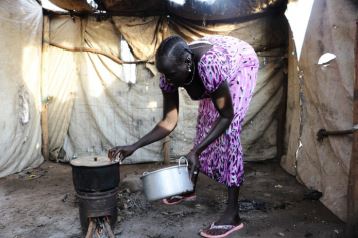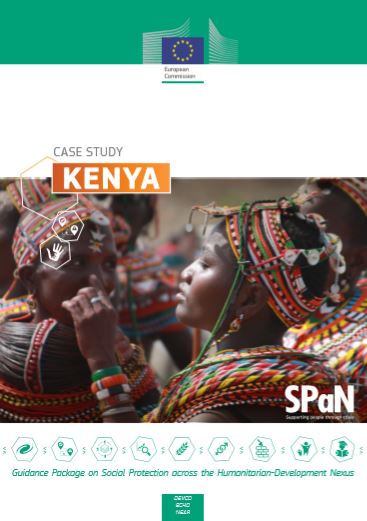SPaN (2019) Case Study: Kenya - Urban food subsidy

This Case Study on Kenya summarizes the context and main features of the alignment process of humanitarian assistance and national systems after a macroeconomic shock.
Kenya´s rate of urbanisation is outpacing urban infrastructure development and service delivery. More than 50% of the urban population now reside in unplanned, overcrowded informal settlements with limited access to basic services. Most residents rely on informal employment, characterised by low pay and poor working conditions. They are especially vulnerable to rising prices, being highly dependent on the market for household food and non-food needs and with insecure income sources. The Kenya Food Security Steering Group (KFSSG) estimates that at least 3.5 million urban dwellers have difficulty meeting their food needs on a regular basis.
Case Study Kenya (PDF)
The social protection system in Kenya is relatively well developed for a low-income country. In 2009 several cash based social transfer programmes existed including a pension for the elderly, the Orphans and Vulnerable Children (OVC) programme and the Hunger Safety Net Programme (HSNP). However, these either did not have national coverage (i.e. the HSNP) or did not adequately cover the chronically poor in urban areas.
The high dependency on markets and lack of access to social protection meant that the crisis severely affected the poor in urban areas. The KFSSG estimated that 9.5 million people were at risk of starvation, with 4.1 million of these living in urban informal settlements. An Inter-Ministerial Task Force on Food Subsidy, comprising government ministries and international partners (Concern Worldwide, Oxfam and WFP) was created, with the objectives of addressing the present food crisis in urban areas and reducing vulnerability of the urban poor to future crises.
This Task Force mandated the Ministry of Gender, Children and Social Development (MoGCSD) to design and implement a pilot programme to respond to the food crisis. In parallel, Oxfam and Concern Worldwide initiated an emergency ‘urban food subsidy programme’ in the Mukuru and Korogocho informal settlements of Nairobi, with funding from the Swedish International Development Cooperation Agency (SIDA). This aimed to meet immediate needs due to the crisis and, in doing so, influence the Government of Kenya to address the lack of long-term social transfers for the urban poor, as preventative measures against future crises.
The Concern Worldwide and Oxfam programme was implemented in 2009-2010 in two informal settlements, Korogocho in Nairobi and Nyalenda in Kisumu, targeting mainly female heads of households. The ‘relief component’ aimed to provide humanitarian cash assistance to protect slum dwellers’ ability to meet food needs in the face of economic shocks, complemented by referrals to health and psychosocial services. 5 000 households received payments of USD 20 per month for eight months.
An advocacy component aimed to leverage experiences and evidence from the programme to build the case for predictable social transfers for the urban poor. Efforts were made to engage national policy makers in the programme from the beginning. The International NGO’s roles in the Inter-Ministerial Task Force on Food Subsidy enabled them to input directly to the design of the government’s pilot project. Both International NGOs set up project-based operational processes and systems and worked through local community-based organisations to implement the programme. Proactive involvement of the staff from the M inistry of Gender from the very beginning helped to get an early buy-in on the design of the programme and ensure linkages to the Government of Kenya throughout the process.
|
This case study is divided into six parts: Scene setting What it looked like How it was done Operations Monitoring and evaluation What happened next |
To overcome reservations among some members of the Government of Kenya about cash assistance, and to demonstrate the need for social transfers for the urban poor, Oxfam and Concern Worldwide had to engage at all levels and across government departments to provide evidence to support their case. Case studies, video documentation and extensive post distribution monitoring demonstrated to policymakers the programme’s added value and lessons learned. The presentation of findings was crucial for the success of the advocacy component and the programme’s objective of influencing national social protection in the longer term.
Experiences from the emergency programme led the Government of Kenya to implement a pilot social transfer ‘food subsidy programme’ in Mombasa, based on the design of this emergency intervention but as a fully government-owned, resourced and led initiative. In 2015 the government expanded the programme´s coverage to reach approximately 68 000 households. The international NGOs continued to support the government through provision of technical and capacity building support, also encouraging the government to look at alternative payment mechanisms for the food subsidy programme.
The payment mechanism improved significantly, but the system is likely to face challenges if a sudden crisis were to occur in the urban areas, because the programme is not designed to expand horizontally. To overcome this, the Government of Kenya is considering a multiple service provider option, which may promote healthy competition among service providers and also enable faster service to the beneficiaries.
This Kenya case study on urban food sibsidy was produced as part of the “Guidance Package on Social Protection across the Humanitarian-Development Nexus” (SPaN). Another case study on Kenya´s Hunger Safety Net Programme (HSNP) also provides an analytical input on horizontal expansion of shock-responsive social protection system. Visit the Guidance Package´s community page for a full list of SPaN´s studies.

Log in with your EU Login account to post or comment on the platform.